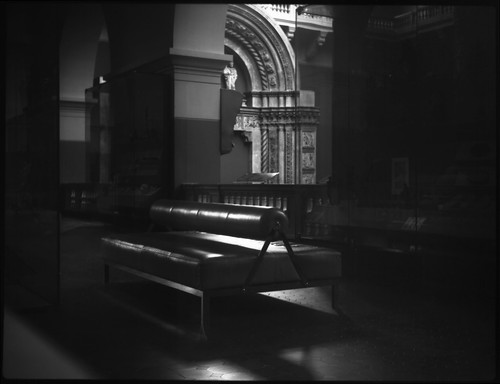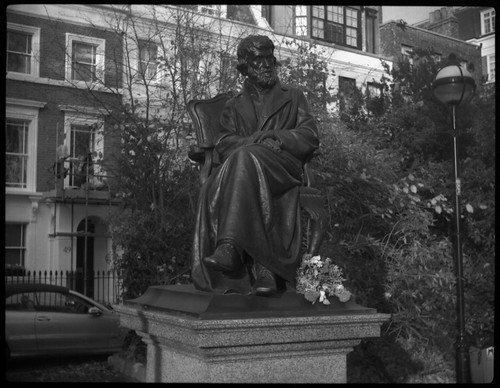 |
| Baby Ikonta with cut-down Rollei Superpan |
Despite neglecting this blog for a few months now, I couldn't not observe last week's
127 Day. I used the
Baby Ikonta again, but had just a couple of rolls of
Kodak High Resolution Aerial Duplicating film cut to 127 size, and a short off-cut from a previously-cut-down roll of
Rollei Superpan 200 (when
cutting down 120 film to 127, the length of the 120 roll is longer than that needed for 127, meaning that with every cut down roll of 120, there's a remainder of film long enough for 5-6 'half'-frames on the '16-on' format); the image above is from the beginning of the short roll which shows that I hadn't accurately lined up the cut end of the film with the start of the numbers on the backing paper. The frames on the Superpan film were hand-held; the Kodak High Resolution Aerial Duplicating film when used as a negative film has a workable ISO of 2. I took most of these photographs in the Victoria & Albert Museum, without a tripod, placing the camera on any level and stable surface I could find that might provide an interesting viewpoint, mostly parapets and benches. I did take one frame, handheld outside, at (I think) 1/10th at f3.5 (the image of Second World War bomb damage to the museum's exterior; another photograph taken outside with this film was made placing the camera on a brick wall).
 |
| Baby Ikonta with Kodak High Resolution Aerial Duplicating film |
On a winter's day, the light levels in the museum are often quite low: exposure times were between 8 seconds and approximately 1 minute. When I developed the film using PQ Universal, it was clear that I could have bracketed more, and, possibly at longer times, the film does exhibit some reciprocity law failure. Scanning the negatives, there was a lot of digital 'spotting' to do: the extremely clear shadow areas show up any specks of dust or dirt incredibly well. The blue-sensitive high-contrast nature of the film also shows how the daylight entering the galleries from skylights caused the floor appearing in some of the frames to appear very bright in comparison to almost everything else in the image, with the exception of some of the plaster casts (such as Michelangelo's David).
 |
| Baby Ikonta with Kodak High Resolution Aerial Duplicating film |
There was also a denser band along one side of one roll of this film, which I haven't found the cause of, but this may be fogging due to cutting the film down by hand under safelights in an insufficiently-dark darkroom, with something partially shading the film. I did think that this could be due to not using enough chemistry when developing, but usually this would show up as a pattern with the image of bubbles from the surface of the developer. This line can be seen to the left of the cast of the architectural façade in the image below.
 |
Baby Ikonta with Kodak High Resolution Aerial Duplicating film
|
The Kodak High Resolution Aerial Duplicating film may also have benefitted from flashing before exposure to raise the shadow values, perhaps something to remember for January's 127 Day. The Rollei Superpan film was less problematic (despite not being taped at quite the right place to the backing paper), but I did use Kodak HC-110 to develop the film, having previously tested this with Rodinal, and worked out a time/temperature/dilution regime to get the best results for my own approach, which I haven't done with HC-110, merely taking the Massive Dev Chart's single recommendation: 6 minutes at dilution B, 1+31 from concentrate.
 |
Baby Ikonta with Kodak High Resolution Aerial Duplicating film
|
 |
Baby Ikonta with Kodak High Resolution Aerial Duplicating film
|
 |
Baby Ikonta with Kodak High Resolution Aerial Duplicating film
|
 |
Baby Ikonta with Kodak High Resolution Aerial Duplicating film
|
 |
| Baby Ikonta with Rollei Superpan 200 |
 |
Baby Ikonta with Rollei Superpan 200
|
 |
Baby Ikonta with Kodak High Resolution Aerial Duplicating film
|











No comments:
Post a Comment